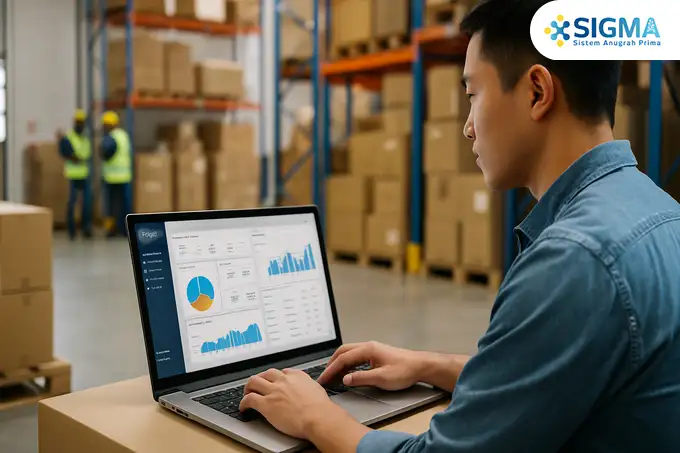Hello, dear readers!
Today, let’s delve into a subject that often causes headaches for those in the retail and distribution industry: the supply chain. Sound familiar? Delayed deliveries, empty shelves despite soaring demand, or worse—products piling up and gathering dust. All of this not only creates stress but also erodes profit margins.
The answer? ERP (Enterprise Resource Planning) systems.
But beware—not all ERP systems are created equal. This is a major investment, and the wrong choice could cost you dearly. What you need is a practical solution—ready to use, result-oriented, and aligned with your business goals.
So let’s explore how to select the right ERP software tailored for retail and distribution, to help you streamline your supply chain—efficiently and without delay.
Why Do Retail and Distribution Businesses Need Industry-Specific ERP?
Many assume that all ERP solutions are the same. Not quite. Retail and distribution come with unique challenges, distinct from manufacturing or pure service sectors. Consider the following:
- High Transaction Volume:
Sales at stores, warehouse activities, deliveries—the volume is overwhelming. Without a robust system, reconciling all this data becomes a nightmare. - Complex Inventory Management:
From perishable goods to items requiring special handling, inventory variations are vast. What’s in store A might differ from the central warehouse. Precision is crucial. - Dynamic Supply Chain:
From suppliers to warehouses to stores, and ultimately to customers—stock is in constant motion. Full visibility is essential to manage it effectively. - Integration with Multiple Systems:
You may have a POS, an e-commerce platform, or third-party logistics providers. Your ERP should seamlessly integrate with them all to avoid data silos. - Rapidly Changing Market Trends:
Flash sales, seasonal items, spontaneous promotions—your ERP must be agile enough to keep up.
If your ERP cannot accommodate these realities, operational chaos is just around the corner. That’s why it’s crucial to choose a solution that understands the intricacies of retail and distribution.
Must-Have ERP Features for Retail & Distribution
Let’s get to the heart of the matter. What features must your ERP include? Here’s a comprehensive checklist to guide your decision:
1. Inventory & Stock Management
- Real-Time Stock Visibility: Know exactly what’s available at each location—instantly. No more stockout surprises.
- Multi-Location Management: Seamlessly control inventory across multiple warehouses and stores.
- Lot & Serial Number Tracking: Essential for traceability—especially in electronics, pharmaceuticals, or food. Critical for recalls.
- Minimum/Maximum Stock Alerts: Automatically get reorder notifications to prevent stockouts and missed sales.
- Stock Transfer & Movement History: Effortlessly transfer items and maintain detailed movement logs.
2. Procurement & Purchasing
- Automated Purchase Orders: Generate POs based on stock levels or sales forecasts—saving time and reducing manual errors.
- Supplier Management: Centralized data, purchase history, and performance metrics for all suppliers.
- Goods Receipt & Invoice Matching: Automatically match received goods to purchase orders and invoices, ensuring accuracy and fraud prevention.
3. Sales Management & POS Integration
- Order Management: Centralize sales from brick-and-mortar stores, e-commerce, and B2B channels.
- Pricing & Promotions: Dynamically manage prices, discounts, and promotional campaigns across all channels.
- POS Integration: Critical. Your ERP must directly connect with in-store POS systems for real-time stock updates and transaction logging.
- Basic CRM Functions: At a minimum, store customer data, purchase history, and preferences to support loyalty programs.
4. Warehouse Management (WMS)
- Picking & Packing Optimization: Guide warehouse staff to fulfill orders faster and more accurately.
- Putaway & Slotting: Organize storage intelligently for faster access and optimal space use.
- Cycle Counting & Auditing: Periodically audit inventory without disrupting operations.
- Barcode & RFID Support: Automate stock handling with scanning technology.
5. Finance & Accounting
- General Ledger, AR & AP: Automatically record all financial transactions with precision.
- Cash Flow Management: Monitor your inflows and outflows to maintain liquidity.
- P\&L Reporting: Generate real-time profit and loss statements for quick insights.
- Tax Compliance: Ensure all records comply with current tax regulations.
- Sales & Purchase Integration: All sales and purchases are immediately reflected in the financial module—seamlessly.
6. Reporting & Analytics
- Custom Dashboards: Visualize KPIs at a glance.
- Sales Performance Reports: Analyze performance by product, store, or salesperson.
- Inventory Turnover Ratio: See how quickly items move through your supply chain.
- Profitability Analysis: Understand profit margins by product or category.
- Demand Forecasting: Anticipate future demand using historical data—vital to avoid overstocking or understocking.
What to Look for in an ERP Vendor

Features aside, the right vendor is equally important. A poor vendor experience can turn your ERP journey into a disaster.
1. Industry Expertise
Choose a provider with a proven track record in retail and distribution. They understand your operations and can provide ready-to-use templates and best practices.
Ask:
“How many retail/distribution clients have you served? Can we speak with references?”
2. Implementation & After-Sales Support
ERP implementation is more than software installation—it involves data migration, process adaptation, and employee training.
After-sales support is essential.
If issues arise, the vendor must respond quickly and effectively.
Ask:
“How is implementation managed? Will we have a dedicated project manager? Is support local or offshore? What’s the typical response time?”
3. Scalability & Flexibility
Your business will evolve—so must your ERP. Look for modular systems that can grow with you.
Ask:
“Can the system be customized to our unique needs? What if we open new branches—how easy is integration?”
4. Deployment Options: Cloud vs. On-Premise
- Cloud (SaaS): Lower upfront cost, faster deployment, accessible from anywhere, vendor-managed updates. Ideal for SMEs.
- On-Premise: Full control, deeper customization, but higher upfront cost and internal IT required. Best for large enterprises.
Choose based on your infrastructure and strategic direction.
5. Total Cost of Ownership (TCO)
Look beyond the software price. Consider implementation, training, customization, maintenance, upgrades, and ongoing support.
Ask:
“What are all the cost components? Are there any hidden fees?”
Real-World ERP in Retail & Distribution
Picture this:
You operate multiple stores and a central warehouse. Without ERP, daily operations are a mess:
- “How many of item A are left in store B? It’s selling fast!” (You call the store or check manually.)
- “Did we place an order with supplier X yet?” (You search through emails.)
- “What’s today’s revenue by store? Gross profit on item Y?” (You’ll know by the end of the month—maybe.)
Now imagine having ERP:
- You open your dashboard and instantly view real-time inventory levels for item A across all locations.
- The system automatically generates a purchase order because stock hit the minimum threshold.
- You see daily sales, profit margins, and sales forecasts by product—instantly.
This is the tangible impact of a well-implemented ERP tailored for retail and distribution: fewer errors, more time saved, and smarter decisions made faster.
What’s Your Next Move?
Choosing an ERP is like choosing the heartbeat of your business. It requires research, discussion, and guidance from experienced professionals. Don’t hesitate to request demos, ask questions, and consult experts.
If your stock is a mess, reports are out of sync, or deliveries keep missing deadlines—those are urgent signs that you need ERP.
Ready to streamline your supply chain and unlock greater profitability in retail and distribution?
PT. Sistem Anugrah Prima (SIGMA) brings decades of experience delivering top-tier ERP solutions for Indonesia’s retail and distribution sectors. We understand your operations inside and out—and how the right technology can transform them.
Our expert team will guide you from start to finish, ensuring a smooth and successful implementation aligned with your goals.
Don’t delay. Visit our website at www.sistemanugrahprima.com or contact our team for a free consultation—and discover how SIGMA’s ERP solutions can become the backbone of your business growth.
Digital transformation is real—and so are the results. Now it’s your turn to experience it.


